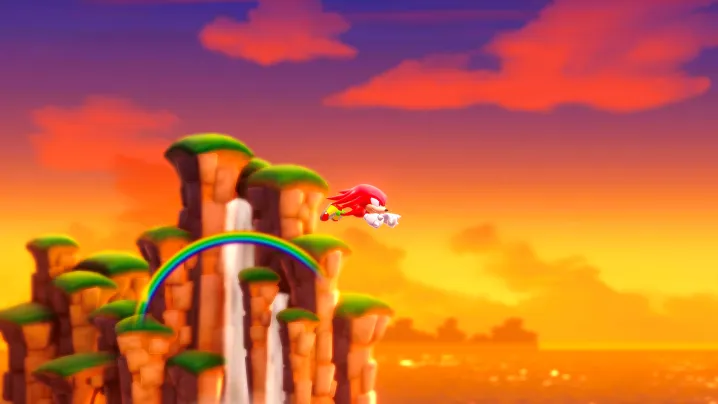
Sonic Superstars is the latest in a long line of 2D Sonic titles, and it’s doing what it needs to stand out. Co-op, Emerald Powers, and a set of all-new levels are not just great back-of-the-box features for a game like this — they also make this a Sonic game that feels a bit different than all of the other 2D Sonic titles that have come before it. And after going hands-on with Sonic Superstars at Summer Game Fest Play Days, I can say this evolution is promising.
Although I didn’t get to try co-op, I saw how the different playable characters could change the game experience, how Emerald Powers enabled Sega to go bigger and bolder with level design, and how this game’s boss fights are already some of the best in the series. If Sega can deliver on all of its promises with Sonic Superstars, this could be the greatest advancement of the 2D Sonic formula in a long time.
More than Mania
In 2018, Sonic Mania perfected the classic 2D Sonic formula with its excellent level design, silky-smooth controls, and boatloads of callbacks and fan service that only served to enhance the experience. It’s hard to do better than almost perfect, so my feeling has been that if Sonic were ever to return to 2D outside of a direct Mania follow-up, its developers would have to go for something that looks and feels a bit different. That’s why I’m glad to see that series publisher Sega and Fantasian and Balan Wonderworld co-developer Arzest made some bold creative decisions with Sonic Superstars.
At its core, Sonic Superstars uses the same level-based platforming formula as most 2D Sonic games, so it’s not reinventing the wheel in that aspect. Thankfully, running and jumping feel great, thanks to excellent momentum-based gameplay that rewards skilled play with exhilarating speed. The first significant difference is how much Sonic Superstars emphasizes its distinct playable characters. Right now, we know that you’ll be able to play Sonic, Tails, Knuckles, and Amy. During my time with the game, I only had a chance to try Knuckles and Sonic.

Each character has distinct abilities and a slightly different game feel. Sonic’s faster and can Drop Dash to get a massive speed boost, while Knuckles can glide and climb over vast expanses of levels. In the final release, I could see myself playing each level four times to see how the experience varies from character to character.
While Sonic has had multiple players before, Emerald Powers feel wholly original to this game. Emerald Powers are special abilities that will allow Sonic and his friends to interact with levels in different ways after they collect a Chaos Emerald. In the four stages that I played, I could use the Water Emerald Power to climb up waterfalls as any character. That’s a relatively straightforward interaction, but it highlighted these stages’ solid level design. The best Sonic levels are big, multilayered affairs where players have lots of opportunities to go fast, but also must deal with unique stage gimmicks.
The four Sonic Superstars stages I tried fit that formula and felt like they had a bit more verticality than the series’ pixel-based 2D titles. Emerald Powers enhanced how much I could explore, and in turn, I was typically rewarded with coins, a medal, or a new elevated path to progress on. The routes these Emerald Powers can open up then pair well with each character’s unique abilities. I managed to make my way up to a point where I could glide over a lot of a level with Knuckles, gained enough speed to clear certain obstacles as Sonic, and came away happy that the game enabled me to do that as both characters.

Forward momentum
Another thing that stood out to me during the Sonic Superstars demo was its bosses. I’d go so far as to say the four bosses I fought during my time with Sonic Superstars are some of the best I’ve seen in a 2D Sonic game. I outran a big mechanical fish trying to eat me as the stage fell apart, ran up a wire shot at me by a boss to damage it, and caused Eggman to attack himself as he launched projectiles at Sonic. None of these radically alter core gameplay, but they enthrallingly test player skills.
It also felt good that all of these boss patterns, and the stages for that matter, weren’t just directly copying ideas or sections from previous games. That isn’t to say there’s no nostalgia-baiting, though; some special stages are based on those in Sonic the Hedgehog 1, and Fang the Sniper is already being teased as an important character. Still, I’m most excited by how different this experience will feel while playing with others. Unfortunately, I wasn’t able to try that out.
While Sonic Superstars’ cooperative play is the main new feature of this game and what most of the game’s reveal focused on, I only had the chance to try it by myself. Doing so did prove to me that Sonic Superstars completely works as a single-player experience, so there is no need to worry about that. Still, I am curious to see how some of the game’s systems could be enhanced in multiplayer. The idea of a Rayman Origins-like experience with Sonic is enticing.

I saw how characters like Knuckles and Sonic have different movesets, but I want to see how they complement or interact with each other. I’d also like to see how things like the special stages and the game’s excellent bosses work when multiple characters are in the fray. While I don’t know how that aspect of the game will be in the final game, this single-player Summer Game Fest Play Days demo of Sonic Superstars still showed a ton of promise.
Across the four levels I played, Super Superstars stood out with satisfying momentum-based controls, expansive and dense level design, distinctive special stages, and some of the best boss fights I’ve played in a Sonic the Hedgehog game. Even if it doesn’t end up reaching the highs of Sonic the Hedgehog 2, 3, or Mania, I’m glad that Sega and Arzest have some forward momentum when it comes to thinking of new ideas about what a 2D Sonic game can be.
Sonic Superstars will be released for PC, PlayStation 4, PS5, Xbox One, Xbox Series X/S, and Nintendo Switch this fall.



